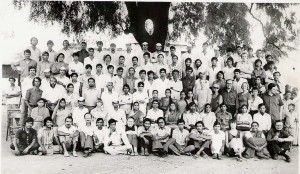HUMAN DEVELOPMENT PROJECTS TEN ASSETS
TEN ASSETS. between 1974 and 1984, the Institute, in collaboration with colleagues and guardians established Human Development projects in local villages and neighborhoods in Australia, Brazil, Canada, Chile, Egypt, England, Germany, India, Indonesia, Italy, Jamaica, Japan, Kenya, Malaysia, Marshall Islands, Nigeria, Peru, Portugal, Samoa, South Korea, Taiwan, The Philippines, United States, Venezuela, Wales and Zambia.
The ICA’s global archive contains over 1000 documents related to human development projects, from internal correspondence, reports, consultation summaries to articles, founder evaluations, task force reports and other reflections. We have included here a smattering of sources. To dig deeper, contact the ICA’s global archive office.
1. PHILOSOPHY AND PRINCIPLES OF LOCAL COMPREHENSIVE HUMAN DEVELOPMENT. Based on extensive research and it’s own experimentation the Institute developed workable principles for community development and community organization. Dorothea Jewell described the approach for In Context magazine in a 1985 article, “Community Development That Works. For a more academic overview, see “Methods for Community Development” Stuart A. Umpleby
2. THE BAND OF TWENTY-FOUR. Within the space of two years, the Institute implemented a bold strategy to establish a visible sign of rapid local development in every time zone around the earth.
http://wiki.wedgeblade.net/bin/view/Main/InYr1976TheBand
3. LAUNCHING HUMAN DEVELOPMENT PROJECTS. A refined process, from initial site selection to visible implementation of programs was developed which centered on a human development consult held on site in the community. George Holcombe describes one.
4. HUMAN DEVELOPMENT PROJECT ACTUATION. Based on the premise of a three year timeline to visibly and measureably transform a community, it’s leadership, and it’s structures, these communities were laboratories for actuation.
5. LOCAL SOCIAL DEVELOPMENT. Structures for local preventive care through the development of local health care takers brought new hope and energy to the HDP communities, especially in the developing world
http://wedgeblade.net/gold_path/data/comd/101197.htm
6. LOCAL ECONOMIC DEVELOPMENT. HDP’s claimed the promise of “tripling the village income” within three years — a challenging and daunting claim that integrated efforts in local agriculture, industry and commerce. http://wedgeblade.net/gold_path/data/comd/100932.htm
7. LOCAL HUMAN DEVELOPMENT. Changing a community’s story about itself, enhancing its physical appearance and infrastructure, and structuring forms of local leadership and cooperation were key.
http://wedgeblade.net/gold_path/data/comd/10029004.htm
8. FRAMING, FUNDING AND OTHER FORMS OF EXTERNAL SUPPORT. HDP’s called forth support from companies, clubs, government agencies and even international development agencies.
http://wedgeblade.net/gold_path/data/comd/10091704.htm
9. THE ROLE OF THE AUXILIARY. A small team of Institute staff and volunteers lived in the community, working and living side by side with local residents, aimed at being a catalytic presence in the community–and working themselves out of a job as rapidly as possible.
http://wedgeblade.net/gold_path/data/comd/10120601.htm
10. EVALUATING HUMAN DEVELOPMENT PROJECTS. A variety of approaches, external and internal, based on hard numbers and soft stories were applied to gauge success.
http://wiki.wedgeblade.net/bin/view/Main/MaliwadaAfterTenYears
11. THE SINGING OF HUMAN DEVELOPMENT PROJECTS. The human development projects inspired over 100 songs.
http://wiki.wedgeblade.net/pub/Main/SudtongganConsult/Sudtonggan.mp3
12. CLUSTER DEVELOPMENT AND REPLICATION SCHEMES. In places where the human development projects created excitement and interest, the institute experimented with various forms of leveraging the successes in the initial project site to catalyze development in other communities and the region.
http://wedgeblade.net/gold_path/data/comd/10120805.htm
13. THE INTERNATIONAL EXPOSITION OF RURAL DEVELOPMENT with ICA as organizing sponsor was implemented in partnership with a number of UN organizations, and involved practitioners in 65 countries in a three year process to identify Approaches That Work in Rural Development.
http://wedgeblade.net/gold_path/data/comd/101574.htm
14. A GEOGRAPHIC INDEX OF HUMAN DEVELOPMENT PROJECT SITES.
http://wedgeblade.net/gold_path/data/world001.htm
15. HUMAN DEVELOPMENT TRAINING INSTITUTES were developed and offered in human development sites around the world as a way to share this human development approach. In each training school, the critical “teaching” was done by the host community and its residents as they showed and told the reality of what they had done. http://wiki.wedgeblade.net/bin/view/Main /InYr1976TrainingSchool
/InYr1976TrainingSchool
http://wiki.wedgeblade.net/bin/view/Main/HDTICurric
Jim Wiegel
That is not the latest symbol of the 24 projects. The 24 are:
1 MAJURO, INDONESIA
2 OYUBARI, JAPAN
3 OOMBULGURI, AUSTRALIA
4 KWANGYUNG IL, SOUTH KOREA x
5 SUDTONGGAN, PHILIPPINES
6 HAI OU, TAIWAN
7 NAM WAI, HONG KONG
8 KELAPA DUA, INDONESIA
9 SUNGEI LUI, MALAYSIA
10 MALIWADA, INDAI
11 KAWANGWARE, KENYA
12 EL BAYAD, EGYPT
13 SHANTUMBU, ZAMBIA
14 TERMINIE, ITALY
15 KREUZBERG OST, BERLIN
16 IJEDE, NIGERIA
17 ISLE OF DOGS, LONDON
18 CANO NEGRO, VENEZUALA
19 IVY CITY, WASHINGTON DC USA
20 LORNE DE L’ACADIE, NEW BRUNSWICK CANADA
21 FITH CITY, CHICAGO USA
22 DELTA PACE, MISSISSIPPI USA
23 INYAN WAKAGAPI, NORTH DAKOTA USA x
24 VOGAR, MANITOBA CANADA